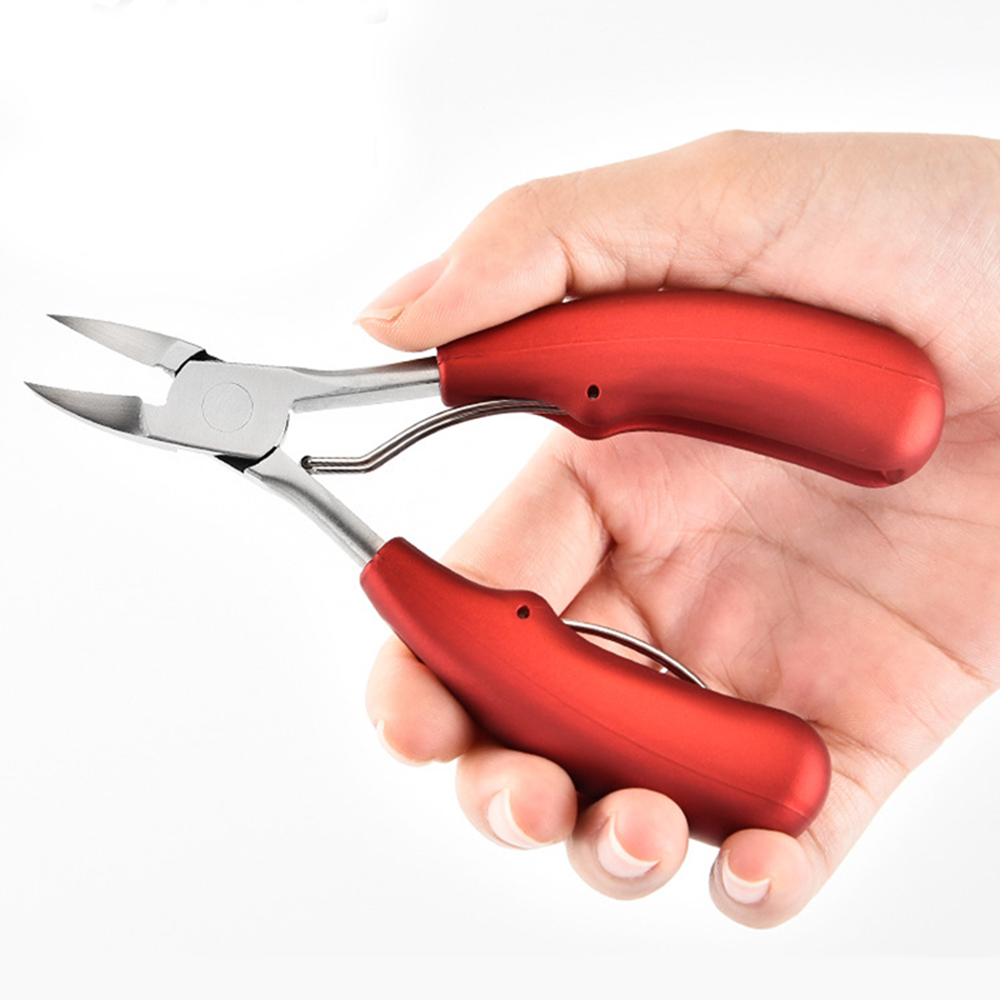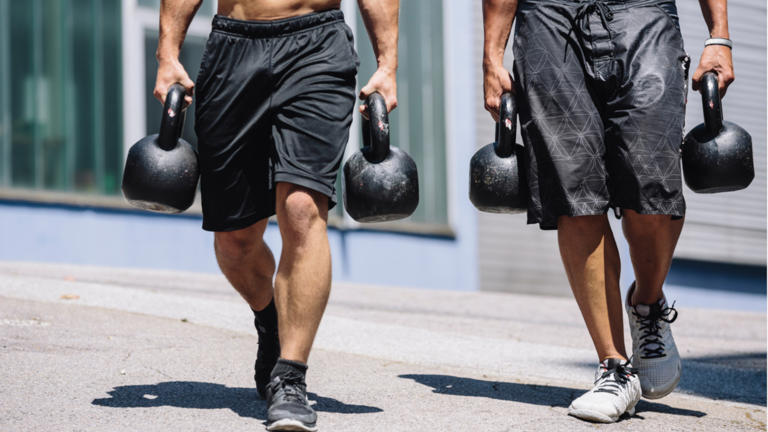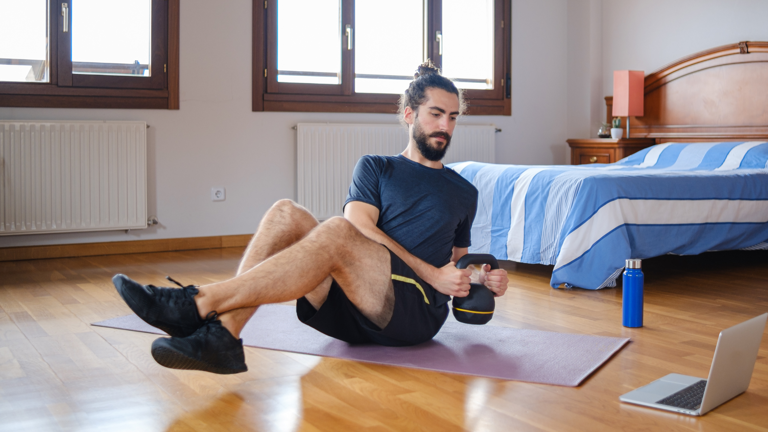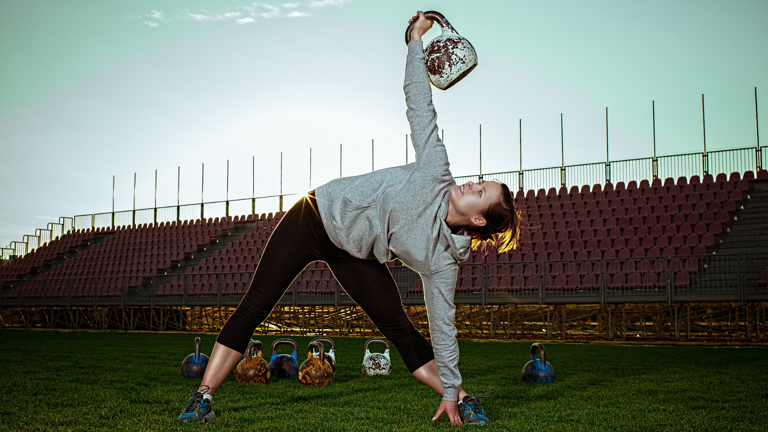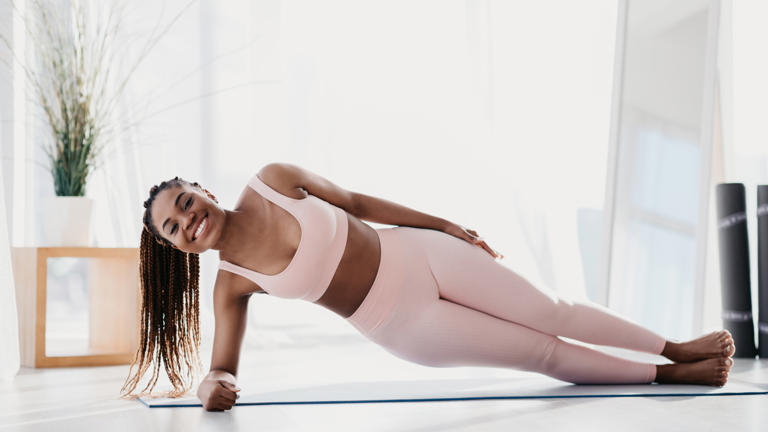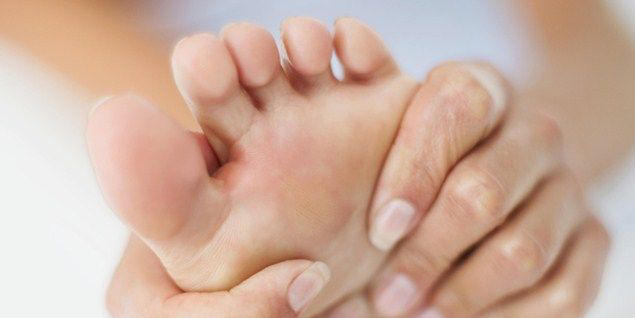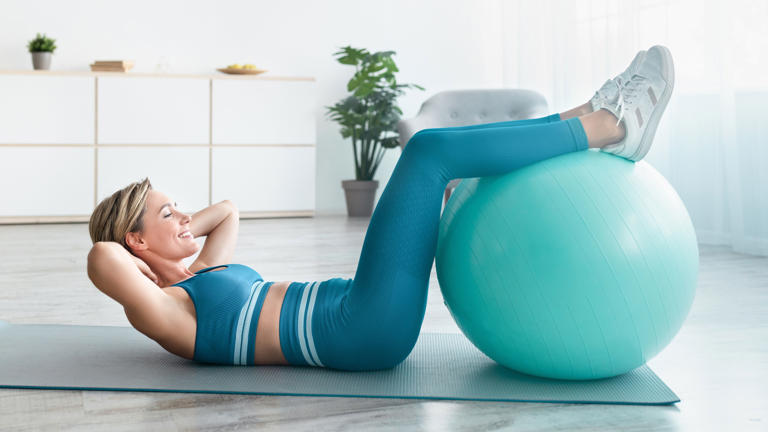10 physio-approved exercises for runners that will help you build strength and mobility
![]()
![]()
![]()
![]()
![]()
10 physio-approved exercises for runners that will help you build strength and mobility
Improving your running performance isn’t just about clocking mile after mile. Of course, this helps, but it’s not the only way. Strength training is also key. From improved performance to preventing injuries, strength training for runners is as important as lacing up your trainers and hitting the pavement.
- Leg (obviously) and core strength play a big part in running performance. You need to keep your legs strong and injury-free to carry your body through each mile you run, and building core strength will help to improve your form, speed, and reduce the risk of common running-related injuries.
That’s why we love this routine from physiotherapist Tash Gale. It focuses on functional exercises for a stronger core and legs as well as improved mobility.
- Functional training is a type of fitness you need to support everyday movement such as sitting, standing, and lifting.
You’ll need a range of equipment—dumbbells (or adjustable dumbbells), a barbell and resistance bands—for all the moves so it’s probably one to save for your next gym day.
- Gale recommends performing 8-12 reps of each exercise. Repeat this for two or three sets for a full workout.
Why should runners strength train?
- Incorporating regular strength training into your running plan is important. Your weekly miles help you build endurance and improve your aerobic capacity, but strength training will help you run for longer and keep injuries at bay.
- Exercises such as squats, lunges, and deadlifts will strengthen your leg muscles. Building the powerhouse of the body (the core muscle) will help your whole body hold its stability and posture, making your running more efficient as your spine and back are better supported.
If you’re looking to improve your running, Fit&Well has a huge catalog of advice and tips. Try these three core exercises for runners and don’t forget to strengthen your hips too.
- Story by Lois Mackenzie: Fit and Well
Forget sit-ups — this 3-move standing ab workout chisels your abs and obliques
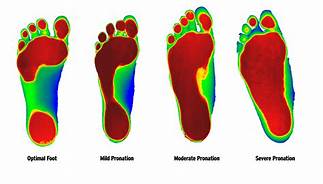





Forget sit-ups — this 3-move standing ab workout chisels your abs and obliques
Hit your core muscles hard, including your abs and obliques, using these three standing ab exercises with or without weights. Here’s how to make just three ab moves pack a punch for your core training.
- You can hold the best adjustable dumbbells or a kettlebell, or stick to using your body weight. However you approach it, build a stronger core with an ab workout that lasts under 20 minutes and without the hassle of gym equipment.
If you’re a beginner, consider using a light weight and focus on form and movement patterns before progressively adding weight.
- It's also worth a quick reminder that how much ab muscle definition you can develop will depend on a variety of factors. Genetics play a role, along with lifestyle decisions around sleep, stress and diet (some more controllable than others) and how regularly you exercise. A consistent resistance training regime and plenty of movement throughout the day (walking or taking the stairs, for example), in conjunction with the factors above, can help improve your chances.
Just remember, building midsection muscle is a process. I'm a fitness trainer and I don't own a six-pack. But there are plenty of other reasons to train your core aside from aesthetics, so here's how to hit those muscles hard in three moves.
Forget sit-ups — what is the 3-move dumbbell standing ab workout?
If your core goals include sculpting ab definition and carving out those obliques, add exercises that hit the muscles responsible for definition. That includes flexion and extension of your torso (think sit-ups) to target the abs and twisting motions like Russian twists to smack the obliques. Thankfully, if you have limited mobility or don’t want to get down on the floor, these moves are best done standing.
- E2MOM x 5-6 rounds
- Prisoner squat crunches x 10-20 reps
- Standing alternating V-ups x 10-20 reps
- Twisted chair pose x 10-20 reps
Complete the set number of reps per exercise within 2 minutes. Start with 10-20 reps of prisoner squat crunches, then move straight to the standing V-ups, followed by the twisted chair pose.
- Rest for the remaining time, then at the 2-minute marker, start from the top and repeat. You’ll work every 2 minutes for 5-6 rounds. Increase the rounds for a longer ab workout. Reps are guidelines only. Increase or decrease as necessary, but try to finish with no more than 20-30 seconds left on the timer before the next round. Here’s a quick run-through of the ab exercises.
1. Prisoner squat crunches
Place your hands behind your head to help activate the upper body and make bodyweight squats more challenging. Pull your shoulder blades together and open your chest without allowing the elbows to draw together. From this standing position, lower into a squat, then tap your left elbow toward your left knee and repeat on the right side. If you prefer, tap your left elbow toward your right knee to add a twist. Hold a dumbbell in each hand to progress the move.
2. Standing alternating V-ups
- Humble V-ups can be done standing up, which is great news if you can’t lie on your back. Start standing with arms extended overhead, then lift one leg into the air in front of you and reach both hands to touch your foot. Place your foot back down and move back to the starting position, then repeat with the other leg. If you need to scale back, bend your knee as you lift your leg. For an extra challenge, hold a dumbbell in each hand.
3. Twisted chair pose
Chair pose, known as Utkatasana in yoga, is often dreaded for its leg-torching capabilities. Sitting in any squat position with your arms overhead also tests shoulder mobility and flexibility in the back muscles. Ground through your feet and keep your heels down, then drive your bum toward the floor and press your hands together in front of your chest, elbows bent.
Hook your left elbow to the outside of your right knee, give it a quick tap, then twist to the opposite side and repeat. Keep your chest lifted and knees bent throughout. Hold two dumbbells together to progress further.
What we like about the 3 standing ab exercises
- Looking at these exercises and thinking — easy? We promise this ab workout is far more challenging than meets the eye.
While performing these compound exercises, focus on squeezing your stomach as if bracing for the impact of a punch. Move with control and slightly slow each exercise down to feel your muscles working through a full range of motion (a technique called time under tension). If that means cutting back on the reps or sets, no problem.
- Various other muscle groups are at play during these ab exercises, including deeper core muscles like the erector spinae and transverse abdominis and your hip flexors, which act as stabilizers. These moves also activate your back, shoulders, chest, arms and legs to facilitate the exercises, so remember to give a healthy squeeze to as many muscles as you can — this is called compound contraction and helps keep the correct muscles active.
There’s also plenty to love about a workout that keeps you accountable. A time cap is a great way to concentrate your efforts, but remember to reduce your reps if you struggle for time rather than rushing and compromising your form
- Story by Sam Hopes: Tom's Guide:
Five exercises better than side bends to sculpt strong obliques






Five exercises better than side bends to sculpt strong obliques
- Training your obliques may not be at the forefront of your mind when you’re on a mission to get a rippling mid-section, often it’s the abdominal muscles we’re headset on. But, to build a set of washboard abs, or improve your overall core strength, you need to give them some love and attention. That being said, we’d avoid the side bend.
- You may have seen others pumping out 12 to 15 reps on either side of their body with a kettlebell or dumbbell in hand, determined to get their ‘side abs’ to show. But have you ever done a side bend and felt your lower back aching afterwards? This is because it places your spine in an uncomfortable position. Throw some weights into the equation and it's even worse.
- You also end up using your hips far more than your obliques to perform the exercise so, in terms of bang for your buck, it’s minimal.
There are far better, functional exercises out there that will strengthen your core and give you a much better ab workout. Here are five of our favourites…
- 1. Single-arm farmers carry
- We’ve previously written about why we love farmer carries on T3, as they’re not just great for your obliques, but your core, arms, shoulders and legs. The traditional farmer's carry is performed with either two kettlebells or a pair of dumbbells. But, by carrying just one weight, instead of two, will challenge your obliques even further as they will be working extra harder to stop your torso from bending and twisting. It’ll also make everyday activities easier too, like carrying the shopping.
2. Russian twist
- This classic core exercise will obliterate your obliques and core. Plus, it can be done using either just your body weight, or you can add some weight into the equation for some extra resistance. A tip from Jeff Cavaliere, Strength and Conditioning Coach and Founder of Athlean-X, focus on driving your elbows back during this exercise. This will ensure you’re actually rotating your torso and not just tapping side to side (which won’t do much).
3. Pallofpress
- Although it sounds like some sort of mechanical machine, the pallofpress is an excellent core exercise that hits the obliques and abdominal muscles. By slowly pressing a cable (or resistance band) out in front of you, and then back again, it challenges your torso to remain stable while under load. As well as sculpting your mid-section muscles, it also has great carryover for loaded movements, the back squat and deadlift.
4. Kettlebell windmill
-
((Image credit: Getty Images))© Provided by T3
- This exercise is slightly more technical, but if you can master it the payoff is worth it. As well as torching the obliques, it also strengthens your glutes, shoulders, lats and improves your hip mobility and flexibility in the hamstrings. As the name suggests, it's usually performed with a single kettlebell, but a dumbbell will work just as well. If you can’t perform the exercise standing, you can do it half-kneeling instead.
5. Side plank
-
((Image credit: Getty Images))© Provided by T3
- Planks are one of the GOAT exercises when it comes to strengthening our core, but this bad boy will particularly fire up the internal and external obliques. Its greatness doesn’t stop there though, as it’s a compound exercise that also works your shoulders, hips and glutes. It doesn’t require any equipment either, but if you do fancy an extra burn, just grab a dumbbell.
- Story by Bryony Firth-Bernard
What to do when plantar fasciitis is so bad you can't walk
![]()
![]()
![]()
![]()
What to do when plantar fasciitis is so bad you can't walk
Managing pain in the foot can be extremely challenging, particularly when conditions like plantar fasciitis prevent you from walking. Unfortunately, it's one of the most common running injuries and can take months to dissipate.
- Plantar fasciitis is especially prevalent in women aged 40 to 60. Those who are overweight have a much higher risk of developing the injury, too, as more load is placed through the foot.
Often associated with repetitive strain and overuse, the condition can flair up when runners overload their training or do too much, too soon. But like with most running-related injuries, the causes are multi-faceted and can be due to biomechanics, footwear and even the shape of your foot.
- How do I know if I have plantar fasciitis?
Sports scientists have been unable to exactly pinpoint whether plantar fasciitis is an inflammatory condition or a degenerative one, but one thing is known: it can be extremely painful. The pain is caused by discomfort of the plantar fascia tissue that spans the underside of the foot, linking the heel bone to the toes. Everything you need to know about what the condition is can be found in our explainer.
- Can plantar fasciitis become so bad you are unable to walk?
- The severity of pain varies widely between different individuals but for some it can lead to a lot of discomfort while walking. At its worst, symptoms typically include a sharp or stabbing pain in the heel or arch of the foot.'
You can often feel a sudden pain when you get up in the morning or if you've been resting for a while,' explains oot health specialist Bente Smith-Rewse, founder of Enertor. 'The pain can get better if you're doing exercises but then it will return after you have rested.'
- When the condition progresses further it can make walking very painful, and trying to walk can actually aggravate, rather than elevate, the symptoms. In some extreme cases, patients can undergo an operation to decrease the stress on the plantar fascia.
- How can you manage plantar fasciitis when you are unable to walk?
- There are a number of steps that can be taken to help your feet recover without putting too much load through them. But the earlier you can address the symptoms the better. Check out this comprehensive guide on preventative exercises that will help stop plantar fasciitis from returning in the long term.
If walking is painful, taking a series of short term measures will help you to manage the pain before you can move onto foot strengthening exercises.
- Stop the activity: First and foremost, stop the activity that is causing the problem. If walking is painful then try to ease back on the amount you do until the pain subsides.
- Pain relief: In the short term, pain relief such as paracetamol or ibuprofen can help to ease symptoms along with icing the sore area. In more extreme cases, a physio may recommend a cortisone injection to ease pain and swelling. This can work in the affected area for up to six months, allowing you to rehabilitate your plantar fascia more effectively. The injection will not cure plantar fasciitis, it will simply mask the pain.
-
- Footwear: Ensuring you have supportive footwear is key to getting you walking without pain again. 'Improve the footwear so that you have support in the arches,' says Smith-Rewse. 'Don't wear anything with a heel or without support. Get really good insoles inside that footwear and it will do wonders.'
- Taping and splints: Taping the foot can help to alleviate pressure, as can a splint or brace for supporting and stretching the arch. However, these should only be used following advice from a medical professional. 'Tape, provided it's done correctly, often works extremely well,' says Smith-Rewse. 'It does mean you have to learn how to do it and be shown by a physio. But tape stabilises the foot so there's slightly less movement.'
- Cross training: If you are unable to walk but want to keep moving, cross training is a fantastic way to stay fit. Ensure it is an activity that doesn't cause pain. Swimming, which is non-weight bearing, can be a great alternative. Take a look at our guide to cross training while injured or our round-up of the best cross trainers for your home.
- Stretching: Simple exercises like rolling a ball or bottle under your foot will help to stretch and roll the plantar fascia tissue. In the beginning, this can help to ease any pain and in the longer term you can build in more foot-specific strength exercises to prevent the condition from returning.
- Shock wave therapy: This is a temporary measure but combined with an insole it can help to reduce recovery time and get you walking sooner. Speak to a physiotherapist to see if this is an appropriate option for your condition and will help to reduce pain.
What can make plantar fasciitis more painful?
- Exercise: Doing the activity that caused the injury is highly likely to increase the pain. Ease off any aggravating exercise and cross train instead.
- High heels: 'Whatever you do, don't wear high heels,' says Smith-Rewse. 'If you have plantar fasciitis, high heels will make it worse.' Squeezing your feet into heels will force more pressure onto your foot, increasing the pain in the tissue band.
- Weight: Weight gain can increase the likelihood of pain because there is more load going through the feet. Plantar fasciitis is more common with people who are overweight so maintaining a healthy weight will help with symptoms.
- Bare feet: 'If you are in pain and then walking barefoot, that is an absolute no, no,' says Smith-Rewse. 'You have to wear footwear to control movement and to give your arch support.' This is particularly the case if you are walking on hard surfaces like stone floors which will worsen the irritation.
Should you seek medical help if you have plantar fasciitis so bad you are unable to walk?
- It is important to seek medical help early on to prevent the condition from worsening and to obtain an accurate diagnosis. A physiotherapist may be able to help stretch the fascia without causing further damage and recommend targeted exercises. In the first instance, get an appointment with your GP. If you are unable to walk then seeking medical advice is a must.
Forget Russian Twists — this 10-minute stability ball workout targets your abs and glutes
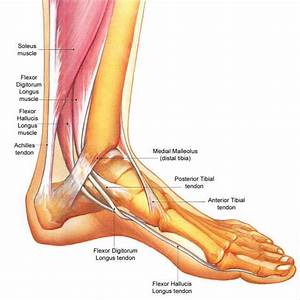








Forget Russian Twists — this 10-minute stability ball workout targets your abs and glutes
- When it comes to stability ball ab workouts, not all exercises are created equal, and you might be wondering where to start. Whether you’ve invested in a stability ball for yoga, and want to add it to your ab workout routine, or you’ve spotted someone using it in the gym and want to give it a go yourself, I’ve got you covered.
Rather than focusing on exercises like Russian Twists, which only target your abdominal muscles, and can put your lower back under a lot of pressure, the exercises in this 10-minute workout hit your abs and glutes. You can do it from home, or in the gym, and all you’ll need is your bodyweight, a stability ball, and a wall.
As a reminder, if you’re new to exercise, or you’re returning to exercise following an injury or pregnancy, this might not be the right workout for you and your body. It’s always a good idea to check with a medical professional before taking on a new workout routine, and if you’re unsure, always ask a personal trainer to check your form to avoid putting yourself at risk of injury.
- What is the workout?
- The 10-minute workout, created by MadFit on YouTube, has five different exercises. Each exercise is performed for 45 seconds, followed by a 15-second break, and you’ll do two rounds of the circuit in total. Stability ball squats
- For this exercise, place the stability ball against the wall behind your lower back, and lean your body weight against the ball. Step your feet slightly wider than hip-width apart, and squat down, rolling the ball down the wall, then straighten your legs to stand back up.
- For this exercise, start on the ground with your lower back pressed into the exercise mat, and your legs outstretched. Hold the stability ball with both hands, with your arms outstretched towards the ceiling. Engage your core, and lift both legs up to the ceiling, then place the ball between your legs, and lower your arms and legs back down to hover a few inches off the ground. After a couple of seconds, lift the ball again, and take it with your hands, this time lowering the ball behind your head as you drop your legs down.
Stability ball hamstring curls
- Place the stability ball on the ground and dig both heels into the ball as you raise your hips up to the ceiling with your legs straight. From here, roll the ball in towards your glutes, keeping them raised to the ceiling and your hips steady, and then roll the ball back out to your starting position. Move slowly and with control.
Stability ball knee tucks and pike
- For this exercise, you’ll need to start by getting into a high plank position on the stability ball. To do this, place your feet on the stability ball, and engage your core to hold a high plank position. From here, tuck your knees into your chest, roll the ball underneath your body, and then reverse the movement so you are back in a high plank position. Then complete a pike, raising your hips up towards the ceiling and raising onto your toes on the stability ball, before lowering back down to a plank.
Stability ball frog pumps
- To do this exercise, start by lying on your back, with your knees bent, and place your feet on the ball so that the soles of your feet are facing each other and your knees are pointing out to the side. From here, raise your hips towards the ceiling and squeeze your glutes. Hold this for a couple of seconds, before lowering your hips back down to the exercise mat. Don’t let your glutes touch the floor throughout the exercise.
What are the benefits?
- The clue to the main benefit of adding a stability ball to your workouts lies in the name — exercising on, or with the ball challenges your stability, and forces the muscles in your core to work harder to keep you steady. A strong core is much more than just an aesthetic goal — it can help you lift heavier weights, run with better form, sit and walk with better posture, and protect your spine from injury.
- However, this workout doesn’t just use the muscles in your midsection — your glutes get a workout here too. The glutes are the largest muscle in the body, but if you spend a lot of time sitting down, you might find they are pretty lazy during your workouts. Strengthening your glutes has several benefits — it can help you avoid injury to your lower back, improve athletic performance, and improve your posture and balance.
Finally, using a stability ball helps you work on your mind-body connection and balance in your workouts. As you wobble on the ball, you’ll have to really think about the muscles you’re trying to engage to complete the exercise, improving this connection in the body. You’ll also work on your front-to-back balance, which can come in handy when lifting weights. So grab that yoga ball and give this workout a try!
- Story by Jane McGuire: Tom's Guide
Articles - Latest
- 10 physio-approved exercises for runners that will help you build strength and mobility
- Forget sit-ups — this 3-move standing ab workout chisels your abs and obliques
- What to do when plantar fasciitis is so bad you can't walk
- Five exercises better than side bends to sculpt strong obliques
- Forget Russian Twists — this 10-minute stability ball workout targets your abs and glutes
- Professor explains how we are all doing one exercise wrong and it is causing us pain
- Supplies, Description, and Usage - Tech Nails-2
- Supplies, Description, and Usage - Tech Nails
- Exercises for Plantar Fasciitis
- Shoes, insoles and splints: Cushioning and support - Plantar fasciitis
- 10 best bum workouts and 25 bum exercises for a 🍑'ier butt
- The dos and don’ts of running when you’re over 40
- This 30-minute workout can be done from just about anywhere
- I teach stretching routines for a living — 3 exercises that strengthen your hips and open your hamstrings
- Somatic exercise has gone viral promising to lower cortisol levels, ease stress, and boost health - so, does it actually work?
- Planks and wall sits best exercise for lowering blood pressure, study says
- Four moves and six minutes is all you need to develop strength with this no-equipment routine
- I did a two-minute Farmer’s Carry every day for a week — here’s what happened
- No squats or lunges: This knee-friendly workout sculpts your lower body in 7 exercises
- Two dumbbells and five moves are all you need to build strength in the shoulders and back
- Add Muscle, Build Stamina and Fire up Your Metabolism with Our Three-Move Strongman Circuit
- How to clean running trainers without ruining them: 3 easy steps to take
- Podiatrist shares pain-inducing mistakes we're making when wearing high heels
- 9 things you need to know before getting acrylic nails
- Running could be just as effective at treating depression as medication, scientists find
Articles-Popular
- Home
- Calluses and Corns-4-Padding and Insoles To relieve Pressure
- Contacts
- Appreciate Your Feet
- WEB - LINKS
- Therapy Price List- Aromatherapy - Counselling
- The Awareness of Foot Care
- Nail Technician Resume
- Join us as a Therapist
- Gallery - Pedicured Feet
- Podiatry/Chiropody Price List
- Skin Care-Feet
- TCM - Therapy Prices
- Blisters on the Feet
- Nail Technician Job Description
- Galleries
- Bacterial Infections
- Itching Skin on the Feet
- Athlete's Foot
- Sweaty or Smelly Feet
- Appointments
- Skin Changes Associated with Blood Flow
- Common Toenail Conditions - Changes in Nail Colour
- Calluses and Corns - 2
- Insoles

